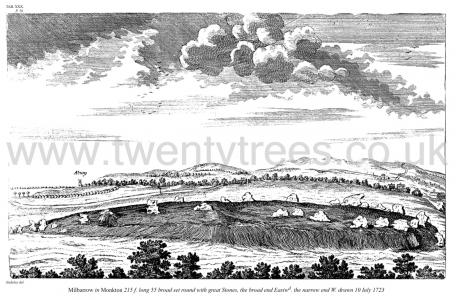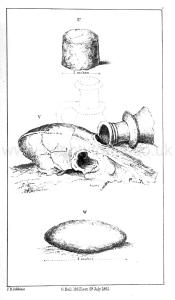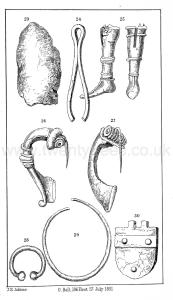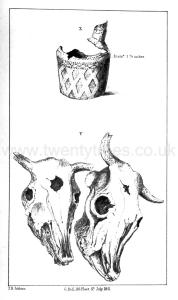Europe, British Isles, South-West England, Wiltshire, Winterbourne Monkton [Map]
Winterbourne Monkton, Wiltshire is in Wiltshire.
Europe, British Isles, South-West England, Wiltshire, Winterbourne Monkton, Millbarrow Long Barrow [Map]
Millbarrow Long Barrow is also in Avebury Long Barrows North.
Carbon Date. 2560BC. Location: Millbarrow Long Barrow [Map]
Report: Antler, id as red deer, 2047, from context 234, primary fill inner ditch, N side at Millbarrow chambered tomb, Winterbourne Monkton, Wiltshire, England. Subm A Whittle 1990. Comment (subm): Compare series OxA-3169 to -3172 and -3198. The series shows activity starting before, but running after, the enclosure on Windmill Hill to the south. [Ed: calibrated dates given in second ref below.]
ID: 7156, C14 ID: BM-2730 Date BP: 4560 +/- 70, Start Date BP: 4490, End BP: 4630
OS Letter: SU, OS East: 95, OS North: 722
Archaeologist Name: A Whittle 1989
Council for British Archaeology (2012) Archaeological Site Index to Radiocarbon Dates from Great Britain and Ireland [data-set]. York: Archaeology Data Service [distributor] https://doi.org/10.5284/1017767
Reference Name: Archaeometry, 34, 1992, 143; Wiltshire Archaeol Natur Hist Mag, 87, 1994, 26
Avebury by William Stukeley. In Monkton, west of the town, is a large and flat long barrow [Map] [Millbarrow Long Barrow [Map]], set round with stones, which I have depicted in plate XXX, 'tis just 120 cubits long, 30 cubits broad in the broadest end. It stands due east and west, the broadest end eastward. Its breadth the fourth part of its length: a most magnificent sepulchre, and called Milbarrow [Map].
Avebury by William Stukeley. Table XXX. Milbarrow [Map] in Monkton 215 f. long 55 broad set round with great Stones, the broad end Eastwd. the narrow end W. drawn 10 Iuly 1723

Wiltshire Archaeological Magazine 1854 V1 Pages 303-304. Tumulus [Monkton Fields Long Barrow [Map]] at Winterbourne-Monkton. Discovery of an Ancient Tumulus, At Winterbourne-Monkton.
A curious, and possibly important discovery, exhibiting one of the ancient modes of sepulture in this country, has recently been made at Winterbourne-Monkton, about three hundred yards west of "Mill-barrow [Map]," and a mile and-a-half north of Avebury.
For many years a large flat Sarsen stone [Monkton Fields Long Barrow [Map]] (partially seen above the surface of the ground) had been the cause of many ungentle maledictions from the various clod-hoppers, who, from time to time, have followed the plough’s-tail in this particular locality. Forbearance being worn out, Mr. Eyles, the present occupier of the land, by whose kindness and assistance we have been allowed to investigate the spot, sent several men to dig a large hole on one side of it,—in fact to bury it. Indoing this they found the soil beneath the stone to be of a different quality from the natural subsoil; which is here chalk marl. They consequently excavated part of the earth and found several human bones, when night put an end to their operations. This discovery led to a more minute investigation, the results of which are as follows:—
The stone is lying flat, and is of considerable size, measuring nine feet four or five inches, each way, and varying from two feet six inches, to nearly four feet in thickness. By removing the soil beneath the stone we discovered a chamber dug in the natural chalk about seven or eight feet in diameter, somewhat circular in shape, and four feet in depth measuring from the under surface of the stone. This chamber was paved at the bottom with small irregularly shaped Sarsen stones, placed so closely that a ‘pick’ could with difficulty be inserted between them. On this pavement were four or five human skeletons, in a most confused state, covered with Sarsen stones, weighing from ten pounds to a half a ewt. each, and about twenty or thirty in number—over these again was a layer of mould up to the top stone which covered all. The skeletons did not seem to have been deposited in any particular direction. The skulls, thigh-bones, &c., were in such close proximity that one would suppose they were originally placed in a sitting posture, when the weight of stones and earth would naturally force them into the apparently confused state in which we found them. The jaw bones were in excellent preservation, as were also the teeth. One jaw evidently belonged to a child, as the second teeth are not cut, but remain still in the jaw.
Wiltshire Archaeological Magazine 1857 V4 Pages 307-363. The Mill barrow at Monkton [Map], a mile or more north of Abury, and of which Stukeley gives an engraving, was 215 feet long and 55 broad, and was set round with great stones, the broad end east, the narrow west. Aubrey says, "The barrow is a yard high at least." It was levelled not many years ago. Dr. Merewether "saw the man who was employed in the profanation. It contained," he said, "a sort of room built up wi' big sarsens put together like, as well as a mason could set them; in the room was a sight of black stuff, and it did smill nation bad."
Europe, British Isles, South-West England, Wiltshire, Winterbourne Monkton 24a [Map]
Winterbourne Monkton 24a is also in Avebury Bronze Age Barrows.
Diary of a Dean by Merewether. No. 24a [Map]. In the small mound on the north side were teeth of deer, oxen, and bones, small fragments of charred wood, and a small sarsen stone partially rubbed.
No. 25b In the opposite mound were similar remains, and in very considerable quantities; and in this was a sarsen (U) 3 inches in diameter rubbed down to a cylindrical form, and the front teeth of an ox.
No. 26c - Five different openings had been made in this long mound, which were afterwards conjoined, and formed one continuous cutting throughout. At 7 was a large half of the os frontis of an ox, and some fragments of horns of deer, one small tip of an ox's horn.
Note d. Here, at about a foot from the surface, was found the head of apparently a greyhound (V), and close by the side a fragment of a small ampulla of Koman form, but somewhat coarse pottery; below was a flat sarsen (W) rounded at the edge and slightly convex.

Europe, British Isles, South-West England, Wiltshire, Winterbourne Monkton 25 [Map]
Winterbourne Monkton 25 is also in Avebury Bronze Age Barrows.
Diary of a Dean by Merewether. 25 [Map]. Side and front view of a singular bronze leg, having a groove to make a joint at the knee, and riveted to either limb. These bronze articles were found very near the line of the Roman road (Via Badonica). Could this be part of such a figure as we read of in Petronius? "Larvam argenteam attulit servus, sic aptatam ut articuli ejus vertebreeque laxatse in omnem partem verterentur," &c., pp. 115, 116. [The servant brought a silver skeleton, so fitted that its joints and vertebrae were loosened and turned in every direction]

Europe, British Isles, South-West England, Wiltshire, Winterbourne Monkton 28 [Map]
Winterbourne Monkton 28 is also in Avebury Bronze Age Barrows.
Diary of a Dean by Merewether. No. 28 [Map]. On removing the three sarsen stones from the apex, about a foot deep, appeared the fragments of a small ornamental urn (X) of unbaked and very fragile clay, containing the skull-bones principally of a very young person, the sutures not being joined or knit; near the top was a sarsen, rounded, and about 2 inches in diameter. The material of which this barrow was composed was chalk rubble, very coarse, and not mixed with other substances, as was generally the case, nor were there fragments of bones, or urns, or pottery, as observed in others. At the depth of 5 feet were (Y) the heads of two oxen laid side by side, and in very perfect condition, but very brittle on removal; from the pole to the nose-bone one measured 20 inches, the other 19; from one orbit of the eye to the other 9 inches; in each the centre of the forehead had been fractured in a circular hole. Below these the same hollow character of the chalk continued, and the sides of the chamber, 6 feet in length by 4 feet in breadth, had been carefully cut in the natural chalk. The heads of the oxen were laid across the chamber north-east. At a depth of 5 feet below these, and 10 feet from the top, was the skeleton of an adult (Z), in many parts much decayed, but in the crouched position, lying on the left side; behind the head was a small ornamented urn of unbaked clay (aa) or at least only fire-baked, and not in a kiln; the thigh-bone was 19 inches in length; at the right foot was a small well-chipped flint arrow-head (bb) and a flint spear-head (cc). A second also was subsequently found near the same spot (dd),though not so well formed.


